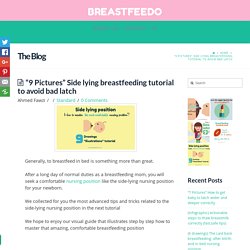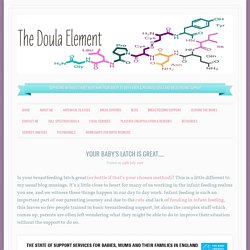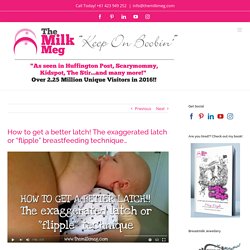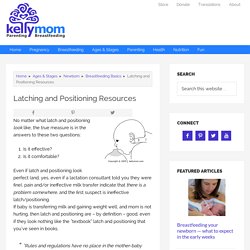

"9 Pictures" Side lying breastfeeding tutorial to avoid bad latch. Generally, to breastfeed in bed is something more than great.

After a long day of normal duties as a breastfeeding mom, you will seek a comfortable nursing position like the side-lying nursing position for your newborn. We collected for you the most advanced tips and tricks related to the side-lying nursing position in the next tutorial We hope to enjoy our visual guide that illustrates step by step how to master that amazing, comfortable breastfeeding position. Side lying breastfeeding. International BreastFeeding Centre. The following information can be used to help your baby latch on and feed well.

This approach is a good starting point when learning to breastfeed and is also helpful for addressing any and all breastfeeding challenges or concerns (including nipple pain, baby not getting enough milk from the breast, and blocked ducts). Keep your baby close by, skin-to-skin if possible, as much as practical, and watch for early feeding cues (e.g. licking lips, bobbing or pecking on your chest, bringing hands toward the mouth). Offer the breast as soon as you see these cues – in other words, feed your baby on demand, when the baby is ready.
Breastfeeding latch - Your Baby's latch is great! Is your breastfeeding latch great (or bottle if that’s your chosen method)?

This is a little different to my usual blog musings. It’s a little close to heart for many of us working in the infant feeding realms you see, and we witness these things happen in our day to day work. Infant feeding is such an important part of our parenting journey and due to the cuts and lack of funding in infant feeding, this leaves so few people trained in basic breastfeeding support, let alone the complex stuff which comes up, parents are often left wondering what they might be able to do to improve their situation without the support to do so. Facebook groups are full of peer support in the form of mum to mum groups offering words of encouragement, support and chat 24 hours a day which is great for moral support and a virtual hug at 3am when things are just exhausting, because somebody else is also on the twilight shift, trying to crack that perfect breastfeeding latch.
Your baby’s latch is great….. How to get a better latch! The exaggerated latch or "flipple" breastfeeding technique... As I discuss here in this video, most babies will latch on the best when they are supported to self-attach on their own, with the mother in the “laid-back” breastfeeding position, or self-attachment in the “koala” hold.

Here is a baby self-attaching in the laid-back position: But what about the babies who cannot latch on well by themselves? How do I get my baby to open wide? Positioning. Video Of The Laid Back Breastfeeding Position-Encourage Your Baby To Self-Attach! Did you know that babies are able to self attach?

It’s awesome to watch and always amazes the mum how easily her baby can attach and breastfeed without her having to do a thing. Often times in hospitals a mum has someone hold her boob, sandwiched like a hamburger while trying to shove the baby’s head onto her nipple! Although this might work in getting baby to attach, it creates stress for the mum, does not allow the baby to tune into their own instincts and leaves the mum to head home without an extra hand for boob sandwiching! As new mums we are often times obsessed with how our baby’s mouth looks, what position it’s head is in and how we are holding them while trying to latch them on. Exaggerated latch/deep latch/flipple. Latching and Positioning Resources. No matter what latch and positioning look like, the true measure is in the answers to these two questions: Is it effective?

Is it comfortable? Even if latch and positioning look perfect (and, yes, even if a lactation consultant told you they were fine), pain and/or ineffective milk transfer indicate that there is a problem somewhere, and the first suspect is ineffective latch/positioning. How do I position my baby to breastfeed? Note: For clarity, we are referring to baby as "he" and mother as "she.

" During the early weeks optimal positioning is especially important. When you and your baby are well positioned, your nipples stay healthy and your baby can feed most efficiently. Latch and Positioning. Your baby has instincts and reflexes that help him to latch onto your breast and feed.

You also have instincts for helping your baby to breastfeed. Even so, sometimes breastfeeding can be difficult in the beginning. The following suggestions may help you and your baby to breastfeed more easily and comfortably. Stay in skin-to-skin contact, as much as possible, until your baby is breastfeeding easily. Skin-to-skin contact promotes stable temperature, heart rate, breathing and blood sugar. Many Moms May Have Been Taught to Breastfeed Incorrectly: Surprising New Research - Mothering.
This article from Nancy Mohrbacher, IBCLC, FILCA was featured in Holistic Parenting magazine, Issue 9 (May/June 2015).

Nancy is a wealth of knowledge and a light to many breastfeeding mothers! During the more than 30 years I’ve been helping breastfeeding families, it’s been thrilling to see the rise in U.S. breastfeeding rates. In the early 1980s, only about 50% of American women breastfed even once. Now nearly 80% of new mothers breastfeed. But this picture is still far from rosy. How to Breastfeed - Deep Latch Technique. How to get a better latch! The exaggerated latch or "flipple" breastfeeding t... As I discuss here in this video, most babies will latch on the best when they are supported to self-attach on their own, with the mother in the “laid-back” breastfeeding position, or self-attachment in the “koala” hold.

Here is a baby self-attaching in the laid-back position: But what about the babies who cannot latch on well by themselves? What about the babies with tongue ties or other physical issues going on that inhibit their ability to keep enough of the areola in their mouth while breastfeeding? This is where the “flipple” technique can really help. In the following video I discuss how this little breastfeeding trick can work even better if the mother does this while her baby is in the “koala” position which looks like this: Latch on Techniques for Breastfeeding : Breastfeeding : Babies. If you are a mom that is struggling to get your baby to latch on, you may be feeling frustrated, emotional, and defeated.
Breastfeeding is supposed to be a natural process and yet your baby just can’t get it figured out. When you look for advice, you may find that the instructions for latching on are so complicated and contain so many details that you just can’t keep it all straight. 01_laid_back_breastfeeding. Some Ins and Outs of Laid-Back Breastfeeding. These laid-back positions not only make breastfeeding less work for mothers, they also make it easier for babies to take the breast deeply, especially during the early weeks. That’s because in these positions gravity helps rather than hinders babies’ inborn feeding reflexes, which can make a huge difference when babies are at their most uncoordinated. After decades of teaching mothers to breastfeed sitting upright or lying on their sides, many have difficulty visualizing this new approach.
The latch looks great! Really?! Tell that to my burning nipple... Causes of nipple pain while breastfeeding and why it does not matter what someone thinks of the latch… “The latch looks fine! “Ooooohhhh wait, that doesn’t look right” The following photo states this is a “correct” latch, however for many women the latch will never look like this, even though it’s correct for them!
“He is not latched on right” the child health nurse said. Deep Latch Technique. In order to get milk from the breast, the baby must latch onto the breast. The word "latch" describes the way a baby takes the breast into his/her mouth. The better the latch, the more easily the baby gets mother's milk.
Engorgement Help: Reverse Pressure Softening. Finnish | Russian by K. Jean Cotterman RNC, IBCLC. Reprinted with permission from the author. More health care providers are observing that mothers receiving multiple intrapartum IV’s experience delay in expected postpartum fluid shift. No pain, no gain? What EXACTLY do we mean by breastfeeding pain? - The Birth Hub.